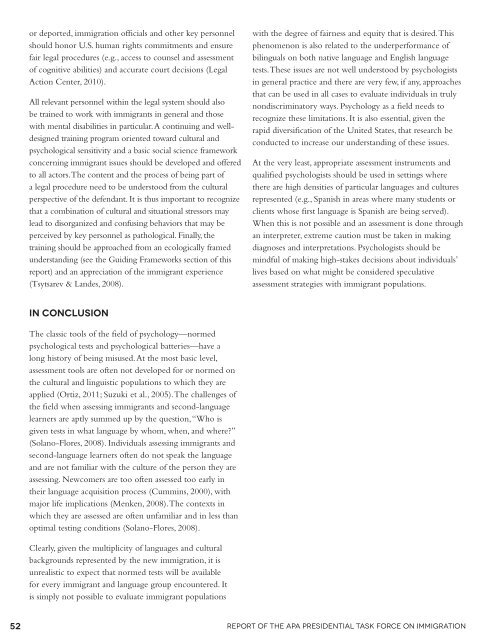Crossroads: The Psychology of Immigration in the New Century
Crossroads: The Psychology of Immigration in the New Century
Crossroads: The Psychology of Immigration in the New Century
You also want an ePaper? Increase the reach of your titles
YUMPU automatically turns print PDFs into web optimized ePapers that Google loves.
or deported, immigration <strong>of</strong>ficials and o<strong>the</strong>r key personnel<br />
should honor U.S. human rights commitments and ensure<br />
fair legal procedures (e.g., access to counsel and assessment<br />
<strong>of</strong> cognitive abilities) and accurate court decisions (Legal<br />
Action Center, 2010).<br />
All relevant personnel with<strong>in</strong> <strong>the</strong> legal system should also<br />
be tra<strong>in</strong>ed to work with immigrants <strong>in</strong> general and those<br />
with mental disabilities <strong>in</strong> particular. A cont<strong>in</strong>u<strong>in</strong>g and welldesigned<br />
tra<strong>in</strong><strong>in</strong>g program oriented toward cultural and<br />
psychological sensitivity and a basic social science framework<br />
concern<strong>in</strong>g immigrant issues should be developed and <strong>of</strong>fered<br />
to all actors. <strong>The</strong> content and <strong>the</strong> process <strong>of</strong> be<strong>in</strong>g part <strong>of</strong><br />
a legal procedure need to be understood from <strong>the</strong> cultural<br />
perspective <strong>of</strong> <strong>the</strong> defendant. It is thus important to recognize<br />
that a comb<strong>in</strong>ation <strong>of</strong> cultural and situational stressors may<br />
lead to disorganized and confus<strong>in</strong>g behaviors that may be<br />
perceived by key personnel as pathological. F<strong>in</strong>ally, <strong>the</strong><br />
tra<strong>in</strong><strong>in</strong>g should be approached from an ecologically framed<br />
understand<strong>in</strong>g (see <strong>the</strong> Guid<strong>in</strong>g Frameworks section <strong>of</strong> this<br />
report) and an appreciation <strong>of</strong> <strong>the</strong> immigrant experience<br />
(Tsytsarev & Landes, 2008).<br />
In Conclusion<br />
<strong>The</strong> classic tools <strong>of</strong> <strong>the</strong> field <strong>of</strong> psychology—normed<br />
psychological tests and psychological batteries—have a<br />
long history <strong>of</strong> be<strong>in</strong>g misused. At <strong>the</strong> most basic level,<br />
assessment tools are <strong>of</strong>ten not developed for or normed on<br />
<strong>the</strong> cultural and l<strong>in</strong>guistic populations to which <strong>the</strong>y are<br />
applied (Ortiz, 2011; Suzuki et al., 2005). <strong>The</strong> challenges <strong>of</strong><br />
<strong>the</strong> field when assess<strong>in</strong>g immigrants and second-language<br />
learners are aptly summed up by <strong>the</strong> question, “Who is<br />
given tests <strong>in</strong> what language by whom, when, and where?”<br />
(Solano-Flores, 2008). Individuals assess<strong>in</strong>g immigrants and<br />
second-language learners <strong>of</strong>ten do not speak <strong>the</strong> language<br />
and are not familiar with <strong>the</strong> culture <strong>of</strong> <strong>the</strong> person <strong>the</strong>y are<br />
assess<strong>in</strong>g. <strong>New</strong>comers are too <strong>of</strong>ten assessed too early <strong>in</strong><br />
<strong>the</strong>ir language acquisition process (Cumm<strong>in</strong>s, 2000), with<br />
major life implications (Menken, 2008). <strong>The</strong> contexts <strong>in</strong><br />
which <strong>the</strong>y are assessed are <strong>of</strong>ten unfamiliar and <strong>in</strong> less than<br />
optimal test<strong>in</strong>g conditions (Solano-Flores, 2008).<br />
Clearly, given <strong>the</strong> multiplicity <strong>of</strong> languages and cultural<br />
backgrounds represented by <strong>the</strong> new immigration, it is<br />
unrealistic to expect that normed tests will be available<br />
for every immigrant and language group encountered. It<br />
is simply not possible to evaluate immigrant populations<br />
with <strong>the</strong> degree <strong>of</strong> fairness and equity that is desired. This<br />
phenomenon is also related to <strong>the</strong> underperformance <strong>of</strong><br />
bil<strong>in</strong>guals on both native language and English language<br />
tests. <strong>The</strong>se issues are not well understood by psychologists<br />
<strong>in</strong> general practice and <strong>the</strong>re are very few, if any, approaches<br />
that can be used <strong>in</strong> all cases to evaluate <strong>in</strong>dividuals <strong>in</strong> truly<br />
nondiscrim<strong>in</strong>atory ways. <strong>Psychology</strong> as a field needs to<br />
recognize <strong>the</strong>se limitations. It is also essential, given <strong>the</strong><br />
rapid diversification <strong>of</strong> <strong>the</strong> United States, that research be<br />
conducted to <strong>in</strong>crease our understand<strong>in</strong>g <strong>of</strong> <strong>the</strong>se issues.<br />
At <strong>the</strong> very least, appropriate assessment <strong>in</strong>struments and<br />
qualified psychologists should be used <strong>in</strong> sett<strong>in</strong>gs where<br />
<strong>the</strong>re are high densities <strong>of</strong> particular languages and cultures<br />
represented (e.g., Spanish <strong>in</strong> areas where many students or<br />
clients whose first language is Spanish are be<strong>in</strong>g served).<br />
When this is not possible and an assessment is done through<br />
an <strong>in</strong>terpreter, extreme caution must be taken <strong>in</strong> mak<strong>in</strong>g<br />
diagnoses and <strong>in</strong>terpretations. Psychologists should be<br />
m<strong>in</strong>dful <strong>of</strong> mak<strong>in</strong>g high-stakes decisions about <strong>in</strong>dividuals’<br />
lives based on what might be considered speculative<br />
assessment strategies with immigrant populations.<br />
52 Report <strong>of</strong> <strong>the</strong> APA Presidential Task Force on <strong>Immigration</strong>
















